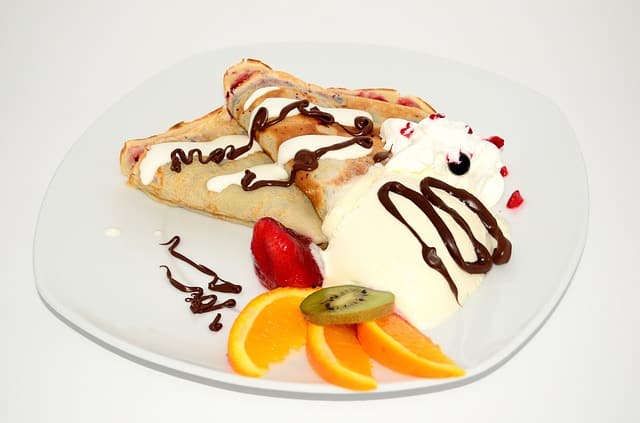Okonomiyaki: ‘Whatever You Like in a Pancake’
If you have ever been to Japan, you might have seen self-service teppanyaki restaurants serving okonomiyaki (Japanese pancakes) and yakiniku (BBQ meat), in which diners cook their own food on a griddle. This post explains how to make Japanese pancakes (okonomiyaki) and explores pancake culture in Japan.
What Are Okonomiyaki?
Okonomiyaki, an extremely popular kind of savory Japanese pancake consisting primarily of batter and cabbage, is a dish served at festivals, in restaurants and in homes throughout Japan. Unlike most Japanese food whose ingredients are dictated by Japanese customs, okonomiyaki are completely customizable, allowing you to add or substitute any ingredients you like. In Japanese restaurants you build your own pancake, choosing whichever toppings you like from the menu. Usually, you are left to cook your own pancake using a griddle. However, if you are new to okonomiyaki, a chef will happily show you how to cook your Japanese pancake. This kind of restaurant is normal in Japan. In the UK, food hygiene and health and safety laws would probably have something to say! Okonomiyaki comes from two different regions. One is Osaka, where The Japanese Shop’s owner, Hiromi, comes from. The other one is Hiroshima style. According to The Guardian, Osaka style is characterised by the mixing of all the ingredients into one batter, while Hiroshima style is where a plain pancake is grilled and topped with extras. A traditional okonomiyaki is topped with special okonomiyaki sauce (tastes very similar to a thick, sweet, Worcestershire sauce) and finished with bonito fish flakes. Osaka-style okonomiyaki are regarded as the easiest to make and are an enormously popular feature in Japanese restaurants. Hiroshima okonomiyaki are slightly trickier to make as they are built up of several layers of pancake and toppings. You name it: thin Japanese pancake, shredded cabbage, noodles, eggs, other kinds of topping and so on. If you put all of them in, it becomes like a mountain! But professionally made pancakes should be flat.
Osaka-style okonomiyaki are regarded as the easiest to make and are an enormously popular feature in Japanese restaurants. Hiroshima okonomiyaki are slightly trickier to make as they are built up of several layers of pancake and toppings. You name it: thin Japanese pancake, shredded cabbage, noodles, eggs, other kinds of topping and so on. If you put all of them in, it becomes like a mountain! But professionally made pancakes should be flat. A few years ago, Jonathon Ross tried out an okonomiyaki recipe on Gordon Ramsay’s TV programme. Although it looked as though it was authentic and had been cooked properly, Gordon was not impressed. To watch the video, follow this link: https://www.youtube.com/watch?v=owaZ1FHihfw
If you would like to try your hand at making a Japanese pancake at home, try this easy okonomiyaki recipe from Jamie Oliver’s latest cookbook:
A few years ago, Jonathon Ross tried out an okonomiyaki recipe on Gordon Ramsay’s TV programme. Although it looked as though it was authentic and had been cooked properly, Gordon was not impressed. To watch the video, follow this link: https://www.youtube.com/watch?v=owaZ1FHihfw
If you would like to try your hand at making a Japanese pancake at home, try this easy okonomiyaki recipe from Jamie Oliver’s latest cookbook:
Quick and Easy Okonomiyaki Recipe
(makes about 5) Ingredients Filling:- ½ cabbage
- 1 carrot
- 3 spring onions
- 1 sq. cm ginger
- 3 mushrooms
- 3 green beans
- 2 eggs
- 100g plain flour
- 200ml water
- 60g cheddar cheese
- Some sliced bacon
- 50g brown sauce
- 5g oyster sauce
- 2g ketchup
- ½ tsp English mustard
- 5g honey
- Mayonnaise and nori seaweed for topping
How to Make Japanese Pancakes
1. Cut vegetables into small pieces and put in a bowl. 2. Add the flour, egg and water and mix really well. Add the grated cheese and mix this in, too. 3. Heat a little oil in a large frying pan at a very low heat. Add the bacon and vegetable mix and tilt the pan until the mixture forms a circle. Don’t touch this until really well baked on the bottom side. Then turn it onto the other side to fry for a few minutes. Push it using a spatula to make sure it’s flat and well cooked. 4. Meanwhile, make the sauce. Put all the sauce ingredients in a small bowl and mix well. 5. Once both sides are well cooked, put the pancake on a serving dish. Spread over the sauce, add some mayo and nori seaweed and enjoy!If you love pancakes and are planning a trip to Japan’s capital, don’t miss out on the 12 best pancakes in Tokyo.
Did you enjoy learning how to make Japanese pancakes? Follow us on Facebook or Twitter where you can keep up to date with all our latest blog posts, including authentic Japanese recipes and articles on Japanese art and culture.

